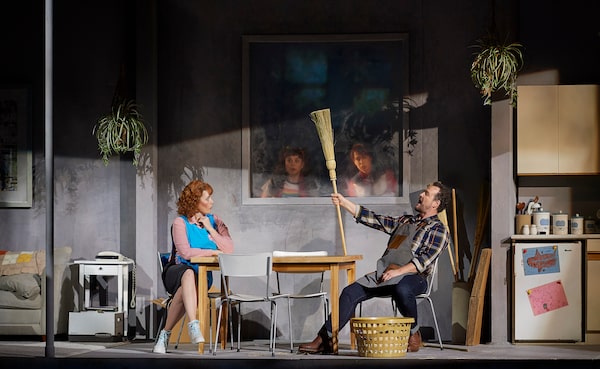
Simone Osborne as Gretel, Emily Fons as Hansel and Michael Colvin as The Witch in the Canadian Opera Company's new production of Hansel & Gretel, 2020.Michael Cooper 2020 coopershoots.com
The Canadian Opera Company’s new production of Hansel and Gretel has arguably been the most anticipated event of its current season, and it’s mostly because of director Joel Ivany.
For those paying attention, Ivany is the man behind Against the Grain Theatre, the indie opera company known for turning classic operas upside down. Ivany has built his career around asking the kind of broad-strokes questions fitting of any decent artist (or philosopher): What if? and Why? and Why not? It’s this type of pondering that led to Ivany’s signature “transladaptations” (translated adaptations, of course) of classic works such as Puccini’s La bohème, sung in English and presented at one of Toronto’s best dives, the Tranzac Club – and Mozart’s Le nozze di Figaro (Figaro’s Wedding), another English-language updating, set integrative-theatre style at one of the city’s hippest wedding venues, the Enoch Turner Schoolhouse.
And now, Ivany presents a brand new staging of Hansel and Gretel, the 1893 opera by Engelbert Humperdinck and his sister Adelheid Wette, based on the fairy tale by the Brothers Grimm. Ivany swaps the 19th-century German forest for a present-day apartment complex in Toronto’s famously rough Jane and Finch area. It’s a rare Canadian spin on Regietheater, the industry term for a production that’s been uprooted from its organic, “normal” context, and placed precariously elsewhere. Claus Guth gave us La bohème on the moon, Hans Neuenfels filled Lohengrin with rats and now Joel Ivany has smushed a gingerbread house into a studio apartment.

Emily Fons as Hansel, Michael Colvin as The Witch and Simone Osborne as Gretel in the Canadian Opera Company's new production of Hansel & Gretel, 2020.Michael Cooper 2020 coopershoots.com

(foreground) Krisztina Szab— as Gertrude and Russell Braun as Peter with (background, l-r) Simone Osborne as Gretel and Emily Fons as Hansel in the Canadian Opera Company's new production of Hansel & Gretel, 2020.Michael Cooper 2020 coopershoots.com
The overture is a treat for those of us who grew up on 1990s movies. Backed by Humperdinck’s perfectly beautiful opera and using projections designed by S. Katy Tucker, a child’s drawing of a globe zooms into familiar aerial shots of downtown Toronto, eventually moving farther north and farther west, finally coming to the two-storey cross-section of four neighbouring apartments, one of which is the shabby home of Hansel, Gretel and their parents.
For the nosy, the set design by Tucker is ideal. One could spend a full act scanning the contents of every apartment, wondering about how the hoarder upstairs became a hoarder, whether the minimalist decor next door is in the name of style or budget, whether the superintendent has some serious skeletons in his closet. Almost constantly, the main action is flanked by mini-scenes happening with the neighbours. It’s certainly not boring, but a bit dizzying when we add the projected surtitles to the list of things to look at.
And for the ears, this Hansel and Gretel comes with a near-perfect cast. Emily Fons (Hansel) and Simone Osborne (Gretel) master the double-duty of embodying children, while singing like grown-ups; they’re funny and curious, and unafraid to throw their bodies around. They’re also chips off the old block; Krisztina Szabo (Gertrude, their mother) and Russell Braun (Peter, their father) seem to foster a warmth even amid the stress of poverty and unruly kids. And in this production, there’s apparently always time for a good, old-fashioned elaborate prank.
But boy, the devil sure is in those details. It’s worth noting that, in all the success of Ivany’s updated classics, he has historically worked with a new version of the text, translated and tailor-made for his reimagined concept. Yet with his Hansel and Gretel, Ivany and his imagination are working with the full power of Humperdinck’s score, and all of Wette’s original German libretto – complete with mentions of forests and houses made of gingerbread.

A scene from the Canadian Opera Company's new production of Hansel & Gretel, 2020.Michael Cooper 2020 coopershoots.com
As a result, the production consistently bumped up against the practical realities of the opera. Hansel and Gretel are not, in fact, picking strawberries. They’re not in the woods. They’re not actually lost. It’s not a gingerbread house, but a pile of wrapped presents. The Witch is apparently just the superintendent dressed in a crazy getup, but apparently shouting “Hocus pocus!” still causes the kids to freeze and let themselves get imprisoned. And it sure felt like a stubborn choice to serve us German text in the context of a production set in Toronto. It’s not uncommon to translate this one into English, considering it’s supposed to be beloved by adults and kids alike.
The production is clear in its two-pronged approach to storytelling. There is the practical, tangible action of the plot, and there is the affect; the latter is expressed by the truly lovely designs by Tucker, lighting designer JAX Messenger and costume designer Ming Wong. There’s a distinct sense of leaning, perhaps too heavily, on the idea that this is an opera about kids, and kids have big imaginations. That’s a stretch, a band-aid solution to being painted into a creative corner by an ill-fitting concept.
And perhaps the biggest losses of the night were the performances by Anna-Sophie Neher as the Sandman and Dew Fairy, and by Michael Colvin as The Witch. When their characters aren’t truly magical or supernatural, the stakes are dull and low; there’s no wonder, no danger, just two young kids being tricked by the grownups they trust.
There’s some wisdom in the idea behind this production of Hansel and Gretel. Poverty, children’s ability to imagine, the desperation of hardworking parents – these are themes that transcend the world created by the Brothers Grimm. Yet Humperdinck’s opera is earthy, tangible and full of specificity, qualities that simply don’t bend as far as this production demands.